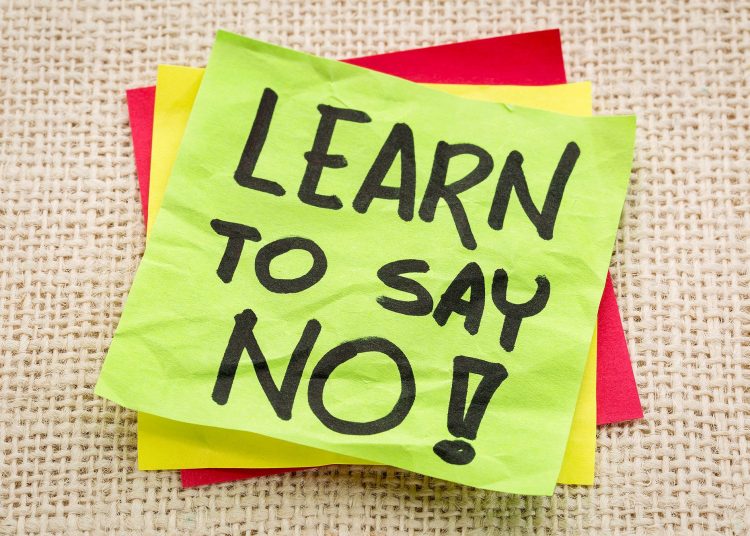
Saying ’no’ can be a daunting task, especially when trying to balance personal needs with maintaining positive relationships. However, learning to say no with confidence is a vital skill that supports boundary-setting and self-respect.
This article will explore how to say no confidently without harming relationships, the importance of boundaries, the pitfalls of not being confident in refusing, and a framework to assist in making wise decisions about when and how to say no.
Why it’s important to say no with confidence
- Preserving time and energy
When you say yes to everything, your time and energy become fragmented. Confidently saying no helps you to prioritise tasks, focus on your own goals and prevent burnout. - Building respect
Assertively expressing a ’no’ can foster respect from others. People are more likely to respect someone who knows their limits and communicates clearly. - Setting healthy boundaries
Saying no is a cornerstone of setting boundaries. It signals that you value your time, energy and personal space, which is essential for healthy relationships, both personally and professionally. - Fostering self-esteem
A confident ’no’ builds self-esteem. It reinforces your sense of self-worth and encourages you to stay true to your values.
Say no without damaging relationships - Be direct but respectful
A straightforward ’no’ can come across as assertive rather than aggressive when it’s delivered with respect. For example: ‘I appreciate the offer, but I have to decline this time.’ - Offer an explanation (but don’t over-explain)
Providing a brief explanation can soften the refusal. However, avoid over-explaining as it can dilute the message and invite further negotiation. For example: ‘I’m unable to take on more tasks right now because of my current workload.’ - Acknowledge the request
Recognising the effort behind the request before declining can help to maintain the relationship. For example: ‘Thank you for thinking of me for this project, but I need to focus on my current priorities.’ - Propose an alternative
If it’s possible, suggest an alternative solution or another time when you may be available. This shows willingness to help while still respecting your limits. For instance: ‘I can’t attend the meeting this week, but I’d be happy to catch up with you next week.’ - Practise active listening
Listening to the other person before saying no can make them feel heard and respected. It helps to ensure that your refusal is based on a full understanding of the request.
Saying no helps set boundaries
- Defines your limits
Saying no sets clear limits about what you are willing to do. It communicates your priorities and what you can accommodate. - Prevents resentment
When you consistently say yes to things that don’t align with your values or capacity, it can lead to frustration and resentment. Saying no prevents this emotional build-up, ensuring a healthier dynamic in relationships. - Encourages accountability
Establishing boundaries through confident refusals encourages others to respect your time and responsibilities, which promotes a culture of mutual accountability.
Implications
These are the possible implications of not being confident in saying no:
- Risk of burnout: Without the ability to confidently say no, you may take on too many commitments, which can lead to burnout and decreased productivity.
- Damaged relationships: A lack of confidence in saying no may result in passive-aggressive behaviour or unmet expectations. This can harm trust and communication in relationships over time.
- Loss of focus: Being unable to decline requests can cause a loss of focus on your own goals. You may find yourself drifting away from your priorities, leading to frustration and dissatisfaction.
- Increased stress levels: The inability to say no often results in stress and anxiety, as you struggle to manage commitments that exceed your capacity.
How to use great judgement before saying no
Before jumping to a decision, it’s crucial to assess the situation carefully. Consider the following:
- Understand the request: Ensure you have a full understanding of what is being asked. Is it a request that aligns with your goals, values or current priorities?
- Weigh the consequences: Consider the potential outcomes of saying no. Will it impact your relationship or your reputation? Will it affect your workload positively or negatively?
- Assess urgency versus importance: Use the Eisenhower Matrix to categorise the request. Is it urgent and important, important but not urgent, urgent but not important, or neither? This helps to clarify if it’s something you should take on or decline.
- Trust your instincts: Sometimes, your gut feeling about a request is a good indicator of whether to accept or decline it. Trust your instincts while also balancing them with reason.
Framework for deciding when to say no
1. The 5-step reflection framework:
- Pause: Take a moment before responding. This helps to prevent impulsive decisions.
- Clarify: Ask follow-up questions if the request is unclear.
- Evaluate: Consider your current priorities and commitments.
- Decide: Make a decision that aligns with your values and goals.
- Communicate: Clearly convey your decision with confidence.
2. Using the CRAFT method:
- Clarity: Be clear about your own goals and values.
- Respect: Respect the person making the request, even as you decline.
- Alternatives: Consider if there are other ways to help.
- Focus: Focus on your priorities and the impact of taking on the request.
- Time: Assess if you realistically have the time for the request.
Conclusion
Saying no with confidence is a skill that can transform how you manage time, energy and relationships. By being direct, respectful and clear, you can maintain healthy boundaries without damaging relationships. Use frameworks like the 5-step reflection and CRAFT method to ensure your decisions align with your goals and values. Remember, saying no is not just about declining requests – it’s about affirming your right to prioritise yourself and your well-being.









